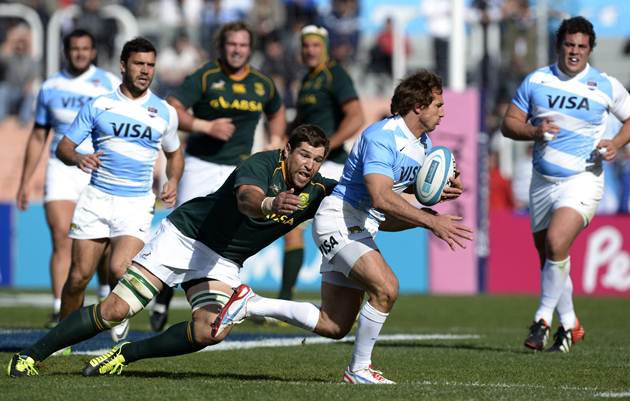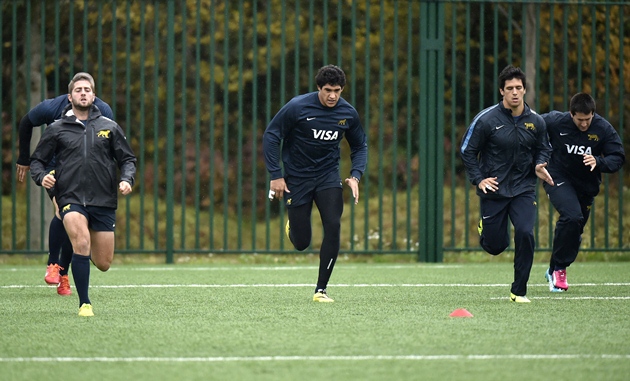Argentina Strength and Conditioning Coach Keir Wenham-Flatt sets out his three key speed training methods to leave the opposition grasping at thin air
If you remember one thing about this article make it this: speed is the most important physical quality you need to succeed in rugby. Strength may get all the accolades but in my experience speed is the true physical ability that separates great players from average players.
A coach I’m fond of quoting frequently says “getting strong is like falling out a boat and hitting water”, and he is right. There are strong players at every level of rugby. The biggest difference I’ve noticed between coaching international players and regular pros is their speed. To me it’s clear: if you want to be a great player, you have to be fast.
Unfortunately speed is also the hardest ability of all to develop through training (and coincidentally the least well understood by players and coaches). With a good programme and several years of dedication is it possible to double your strength, or make similar improvements in some measures of aerobic fitness. This is not the case with speed. A gain in speed of a few percent per year is high-five time.
These two factors – the importance of speed, and its resistance to improvement – mean that the price of inaccuracy in speed training is a costly one. This counts even more when you consider that the vast majority of hamstring, calf and quadricep strains and tears on the field occur during sprinting.
If however you can train sprinting and acceleration speed in a deliberate manner with high quality methods, you can expect to see drastic improvement on the pitch and fewer muscle strains and tears. As an added bonus you can also expect to see an improvement in gym strength (as speed presents a powerful stimulus to the central nervous system which governs strength) and your on-field endurance (by reducing the speed of the game relative to your maximum running speed).
In the list below I am going to share with you the three key training activities that need to be present within a rugby speed training programme. They represent the big building blocks – without them you’ll never fulfil your speed potential. But remember that the devil is in the detail. How you train is just as important as what you train. A more detailed breakdown of these concepts can be found on my website, Rugby Strength Coach.
1. Sprint work
This may seem redundant but if you want to get better at sprinting, you must sprint. There are a number of reasons why sprint work is an absolute necessity for getting fast. The most obvious of these is specificity.
The principle of specificity tells us that the more closely a training activity resembles a sporting action in its movement and force characteristics, the greater the expected performance improvement on the field. Well, there is nothing more sprinting specific than sprinting itself! Sprinting provides a fantastic opportunity to train the muscle and strength qualities needed to run fast.
An additional reason for the inclusion of sprint work in the speed training programme is the powerful effect it exerts on the central nervous system (CNS). The CNS is the source of all power in sporting movement, like a battery in an electric car. The higher the forces and speeds we expose the CNS to, the more it improves its power output. Sprint work is without question the fastest, highest force training activity we are capable of performing which makes it the most effective tool we have for increasing the power of our “battery”. This improves not only sprinting speed but all other fast, powerful actions on the pitch like rucking, tackling, mauling and changing direction.
The final reason is that sprint work provides opportunity to learn and refine the technique required to run as fast as possible. Though it is a natural human movement, sprinting is a skill like any other. Neglecting the skill of running is like building a Formula 1 car and putting a Sunday-afternoon driver behind the wheel. You can have the biggest, fastest engine on the grid, but unless you know how to get it around the track as fast as possible you are doomed to fail.
After a base of good technique is developed at slow speed, frequent sprint work teaches a rugby player how to put this into practice under game conditions. The precise technical requirements of acceleration and top speed running extend beyond the scope of this article (see rugbystrengthcoach.com/speed-guide for a more detailed breakdown), however some key technical points include:
2. Strength and power work
At its heart, sprinting is a game of forces and physics. If you can produce more force and apply it against the ground in an efficient manner, whilst minimising the braking effects of friction and air resistance, you will run faster. To continue the car analogy, increasing strength and power is like increasing the horsepower of the engine. Whilst sprint training itself is a powerful tool to achieve this, gym based strength and power training is an equally effective and necessary tool for achieving maximum rugby speed.
Though any good strength and conditioning programme should develop the whole body, in the context of running fast, particular attention should be dedicated to developing the muscles of the lower body. These are the muscles responsible for applying force into the floor. Specifically the major muscle groups of the gluteals, quadriceps, hamstrings and calves should be targeted.
In terms of sprinting, strength training is fairly general and lays the physical foundation for speed work. As such exercises are largely interchangeable and can be selected based on your preference, individual strengths and weaknesses, body type and injury history. There are no mandatory exercises for running fast other than sprinting itself. However a programme based in basic barbell lifts like the squat, deadlift, step up, lunge and hip thrust is a good idea.
The percentage of one-rep max required to increase strength varies according to training experience (the newer you are to training the less you should use). However reasonably experienced adult players should use in excess of 80% of one-rep max for sets of six or fewer reps. Total sets may be as high as eight but will fall considerably as intensity rises. What is most important is the preservation of good technique and the management of fatigue. It is always better to slightly under-train than over-train.
In the development of power work it is a good idea to select exercises which have little or no inherent slowing of bar speed towards the end of the repetition. This includes ballistic variations of the bench press, squat, deadlift and push press and the Olympic lifts (personally I don’t recommend these due to excessive learning time). The attachment of bands and chains to the bar in traditional exercises can also limit this natural deceleration. Again, sets of fewer than six reps are recommended for eight or fewer sets. Use somewhere between 40-60% of your max to develop power, slightly higher for the Olympic lifts (75-85%).
3. Stretch reflex work
If you haven’t heard of the stretch reflex work, you have definitely experienced it. This reflex is a built in feature of the nervous system. When you stretch a muscle, your body will contract it in opposition to that stretch in order to protect itself. The bigger and faster the stretch, the more forceful the contraction. Ultimately you are able to produce far more force in movements which are preceded by a rapid stretch than without. This is why you can jump higher by dipping rapidly before moving upwards, or throw a ball further by winding up your arm first.
Importantly the stretch reflex is a skill that can be trained. Under the right training conditions the body can be taught to time its force production to increase the stimulation of the stretch reflex (resulting in a more forceful contraction) and to better exploit the stretch reflex (resulting in the greatest possible force production for a given degree of stretch).
Sprinting, particularly at top speed, entails a huge degree of muscular stretch and stimulation of the stretch reflex, which means it is an ideal candidate for methods which enhance these qualities. Three key training tools in achieving this are jumping exercises, plyometrics and medicine ball throws.
These forms of exercise entail movement speeds and a degree of muscular stretch and force that is difficult to replicate in a gym setting. As such they may be considered more sprinting specific and an ideal tool in bridging the gap between the gym and real world sprinting. They also offer a fairly unique opportunity to develop horizontal force production, which recent research has suggested is the primary limiting factor in running fast.
Generally speaking jumping exercises are better suited to the slower movement speeds and bigger joint ranges of movement associated with acceleration running, whereas plyometrics are better suited to top speed sprinting. Medicine balls may be used to develop either quality depending on the execution of exercises. They are also a useful tool to teach the transference of force from the lower to upper body.
If you are new to these training methods it is a good idea to keep things simple, cover your bases and emphasise them equally in your training programme (one session per week dedicated to each is a good idea in pre-season, two mixed sessions is probably more appropriate in-season). Include a mixture of exercises which emphasise faster and slower movement speeds, longer and shorter contact times with the floor, and vertical and horizontal force production. This will ensure good mixture of opportunities to develop the skill of maximally exploiting the stretch reflex and developing force in a highly sprinting specific manner. Again, this list represents a good foundation but more detailed information can be found over at my website.
Keir Wenham-Flatt is a strength coach with Argentina Rugby Union. He has also worked with 2013 NRL Champions the Sydney Roosters, Wasps, Rotherham Titans and London Scottish. Keir is the founder of www.rugbystrengthcoach.com – the web’s #1 resource for rugby strength and conditioning information and can be followed on Twitter @RUGBY_STR_COACH









